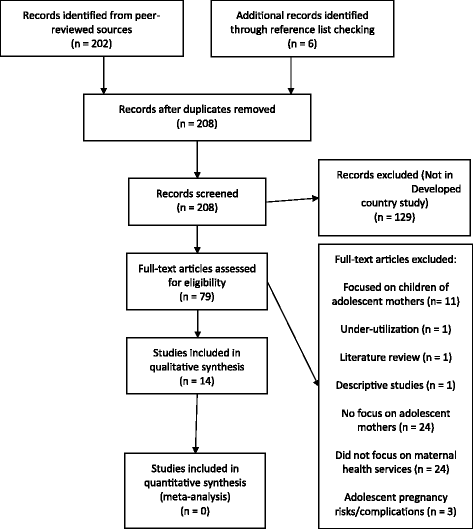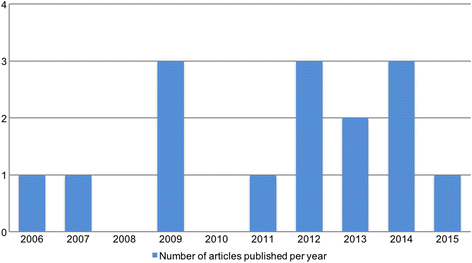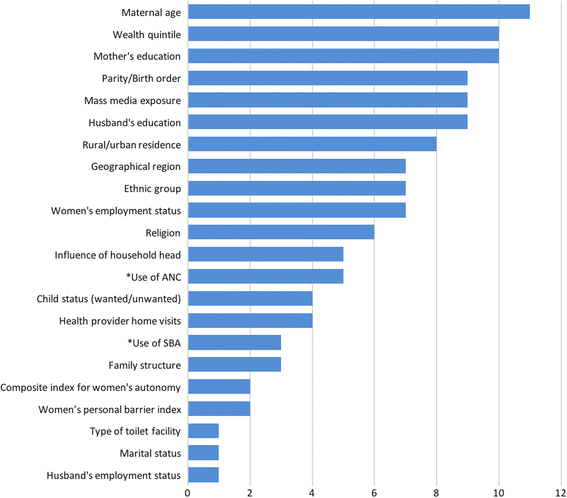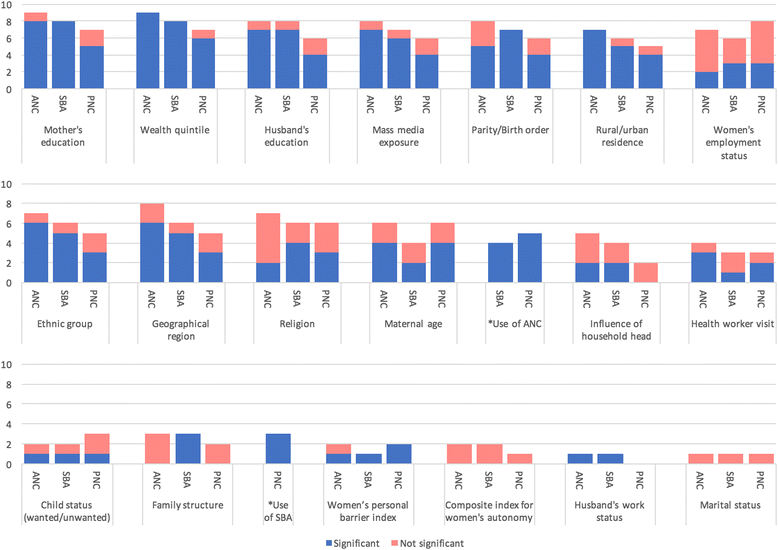Factors influencing utilisation of maternal health services by adolescent mothers in Low-and middle-income countries: a systematic review
- PMID: 28209120
- PMCID: PMC5314631
- DOI: 10.1186/s12884-017-1246-3
Factors influencing utilisation of maternal health services by adolescent mothers in Low-and middle-income countries: a systematic review
Abstract
Background: Adolescent mothers aged 15-19 years are known to have greater risks of maternal morbidity and mortality compared with women aged 20-24 years, mostly due to their unique biological, sociological and economic status. Nowhere Is the burden of disease greater than in low-and middle-income countries (LMICs). Understanding factors that influence adolescent utilisation of essential maternal health services (MHS) would be critical in improving their outcomes.
Methods: We systematically reviewed the literature for articles published until December 2015 to understand how adolescent MHS utilisation has been assessed in LMICs and factors affecting service utilisation by adolescent mothers. Following data extraction, we reported on the geographical distribution and characteristics of the included studies and used thematic summaries to summarise our key findings across three key themes: factors affecting MHS utilisation considered by researcher(s), factors assessed as statistically significant, and other findings on MHS utilisation.
Results: Our findings show that there has been minimal research in this study area. 14 studies, adjudged as medium to high quality met our inclusion criteria. Studies have been published in many LMICs, with the first published in 2006. Thirteen studies used secondary data for assessment, data which was more than 5 years old at time of analysis. Ten studies included only married adolescent mothers. While factors such as wealth quintile, media exposure and rural/urban residence were commonly adjudged as significant, education of the adolescent mother and her partner were the commonest significant factors that influenced MHS utilisation. Use of antenatal care also predicted use of skilled birth attendance and use of both predicted use of postnatal care. However, there may be some context-specific factors that need to be considered.
Conclusions: Our findings strengthen the need to lay emphasis on improving girl child education and removing financial barriers to their access to MHS. Opportunities that have adolescents engaging with health providers also need to be seized. These will be critical in improving adolescent MHS utilisation. However, policy and programmatic choices need to be based on recent, relevant and robust datasets. Innovative approaches that leverage new media to generate context-specific dis-aggregated data may provide a way forward.
Keywords: Adolescents; Ante-natal care; Delivery; Intra-partum care; Maternal health; Maternal health services; Post-natal care; Utilisation of health services.
Figures




Similar articles
-
Home treatment for mental health problems: a systematic review.Health Technol Assess. 2001;5(15):1-139. doi: 10.3310/hta5150. Health Technol Assess. 2001. PMID: 11532236
-
Factors that influence the provision of intrapartum and postnatal care by skilled birth attendants in low- and middle-income countries: a qualitative evidence synthesis.Cochrane Database Syst Rev. 2017 Nov 17;11(11):CD011558. doi: 10.1002/14651858.CD011558.pub2. Cochrane Database Syst Rev. 2017. PMID: 29148566 Free PMC article.
-
Inequities in the continuum of maternal care in Mexico: trends before and after COVID-19.Int J Equity Health. 2025 Jun 17;24(1):178. doi: 10.1186/s12939-025-02470-x. Int J Equity Health. 2025. PMID: 40528188 Free PMC article.
-
Factors that influence parents' and informal caregivers' views and practices regarding routine childhood vaccination: a qualitative evidence synthesis.Cochrane Database Syst Rev. 2021 Oct 27;10(10):CD013265. doi: 10.1002/14651858.CD013265.pub2. Cochrane Database Syst Rev. 2021. PMID: 34706066 Free PMC article.
-
Maternal and neonatal outcomes of elective induction of labor.Evid Rep Technol Assess (Full Rep). 2009 Mar;(176):1-257. Evid Rep Technol Assess (Full Rep). 2009. PMID: 19408970 Free PMC article.
Cited by
-
Multilevel and subnational analysis of the predictors of maternity continuum of care completion in Nigeria: a cross-sectional survey.Sci Rep. 2023 Nov 27;13(1):20863. doi: 10.1038/s41598-023-48240-z. Sci Rep. 2023. PMID: 38012380 Free PMC article.
-
A qualitative analysis of factors that influence Vietnamese ethnic minority women to seek maternal health care.BMC Pregnancy Childbirth. 2019 Jul 12;19(1):243. doi: 10.1186/s12884-019-2375-7. BMC Pregnancy Childbirth. 2019. PMID: 31299937 Free PMC article.
-
A qualitative investigation into pregnancy experiences and maternal healthcare utilisation among adolescent mothers in Nigeria.Reprod Health. 2023 May 20;20(1):77. doi: 10.1186/s12978-023-01613-z. Reprod Health. 2023. PMID: 37208738 Free PMC article.
-
A comparative study of adult and adolescent maternal care continuum following community-oriented interventions in Cambodia, Guatemala, Kenya, and Zambia.PLoS One. 2022 Jan 13;17(1):e0261161. doi: 10.1371/journal.pone.0261161. eCollection 2022. PLoS One. 2022. PMID: 35025914 Free PMC article.
-
How does women's empowerment relate to antenatal care attendance? A cross-sectional analysis among rural women in Bangladesh.BMC Pregnancy Childbirth. 2023 Jun 13;23(1):436. doi: 10.1186/s12884-023-05737-9. BMC Pregnancy Childbirth. 2023. PMID: 37312017 Free PMC article.
References
-
- UN . The united nations convention on the rights of the child. New York: United Nations General Assembly; 1989.
-
- UN . Definition of youth. 2016.
-
- WHO . Reproductive health indicators: guidelines for their generation, interpretation and analysis for global monitoring. Geneva: World Health Organization; 2006.
-
- UNFPA. Motherhood in childhood: facing the challenge of adolescent pregnancy. New York: United Nations Population Fund; 2013.
-
- UNFPA. Adolescent pregnancy: a review of the evidence. New York: United Nations Population Fund; 2013.
Publication types
MeSH terms
LinkOut - more resources
Full Text Sources
Other Literature Sources
Medical
Miscellaneous

